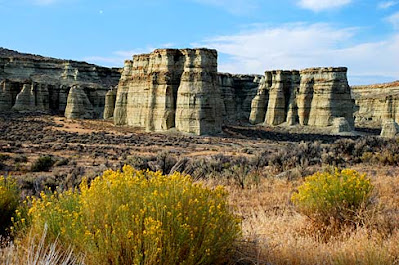Continue to Stand in the Gap: Malheur County
 |
| The Pillars of Rome, Malheur County, OR |
Malheur, the second-largest county in the state, and populated at only three persons per square mile, has a mystique all its own. Ontario, situated along the Snake River which forms the Idaho Border, is the largest town. Vale, the county seat, is situated along the old Oregon Trail and was the first stop in Oregon Territory for the early immigrants. Vale has a population of around 2,000, and the entire county has about 30,000. Like a half-dozen other counties in Oregon, Malheur is under the County Judge system with Dan Joyce the County Judge and Ron Jacobs and Jim Mendiola as Commissioners.
The County
Sheriff is Travis Johnson. The office is still short-staffed in all
divisions, but there have been some new hires and they are working to bring in
more staff. Equipment, such as body cameras and tasers, is also being added,
and records management and dispatch is in the process of being upgraded.
This is
good, as Malheur County is still at or near the top of the list of Oregon high-crime counties. We have touched on the various issues with violence,
drugs, and homelessness here, here, and here.
 |
| Malheur County, Oregon |
This area,
and much of the Oregon Outback including parts of Harney and Lake Counties, was
settled a bit differently than the rest of Oregon. The Willamette Valley was
settled by homesteaders who claimed their homesites via the Homestead Act. A
lot of Central Oregon was settled later in the nineteenth century by ranchers
or farmers who found the Willamette Valley too crowded and moved east for more
elbow room. Many of these were family farms and ranches, although some were able
to acquire large ranches as time went on, buying up neighbors who gave up on
the high dry country.
In Southeast
Oregon, however, those who came and bought up (or claimed through the Homestead
Act) vast amounts of land for livestock operations were based in California –
and stayed in California. They hired ranch managers to run the operations on
the ground, who oversaw the vast ranches with the help of vaqueros – cowboys,
many from Mexico or native Americans from Central California, as well as young,
white, transient men who often worked seasonally. For many years, although
there were some ranch wives and daughters, the population of Malheur and Harney
Counties was overwhelmingly male. Until the very end of the nineteenth century,
in the scattered communities that had schools, even the schoolteachers were men.
The change
in this demographic began with the Bannock War of 1878. This was an uprising of
Bannock and Shoshone (tribes from Southern Idaho) that came over into Oregon and was squashed.
This resulted in a demand for the Malheur Reservation to be dissolved, and
those tribes were moved to the Yakima Reservation or Warm Springs in Central
Oregon. This opened up about two million acres for settlement which attracted settlers
of the more traditional type and by the early twentieth century, the era of the
absentee landowners with huge livestock holdings had diminished. And, of
course, the presence of the indigenous tribes – particularly Northern Paiute –
was also diminished. (Read more here.)
While the population is small, this beautiful southeast corner of the state would benefit from prayer. It has an unusual history of wealthy, absentee landowners and the amazing cultural legacy of the vaqueros. It has been and continues to be, a very conservative area politically, although feeling ignored and outnumbered in Salem. U. S. Representative Cliff Bentz represents this huge area in Congress, and himself resides in Ontario. The rugged land belongs to its own region, larger than many eastern states, that melds into the equally rugged spaces of Idaho and Nevada.
Pray for
our borders.



Comments
Post a Comment